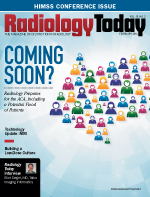 February 2014
February 2014
Improving Pediatric X-Ray Protocols — Image Gently’s New DR Checklist May Also Aid Exam Data Collection
By David Yeager
Radiology Today
Vol. 15 No. 2 P. 6
DR has brought many improvements to the way that X-ray images are captured and processed, but it has created new challenges as well. Although DR has increased the efficiency of obtaining, storing, and retrieving images and reduced the number of repeat examinations, it also requires a more complex set of protocols than film. Generating a clinically useful image while keeping radiation dose as low as possible is a constant balancing act due to variations in patient body masses and types. Nowhere is that balance more precarious than in pediatric radiography.
To help technologists more safely and effectively image children, researchers with the Image Gently campaign have developed a checklist that outlines the critical steps in DR workflow, with an emphasis on steps that affect radiation exposure and image quality.
While technologists who regularly work in pediatric radiography already may have a good grasp of the appropriate protocols, Susan D. John, MD, a professor of radiology and the chair of diagnostic and interventional imaging at the University of Texas Medical School at Houston, says most technologists work with a wide range of patients and may benefit from some guidance about how to image children. “Technologists who do pediatric radiography all day, every day probably don’t need to use this for their own education and verification of their quality,” says John, who also is the first author of the October 2013 Journal of the American College of Radiology article featuring the new checklist. “But there are many, many more technologists that do radiography on pediatric patients only occasionally. It’s that group of technologists that this is targeted to because it’s going to be much harder for them to remember the steps that are different in pediatric radiography from adult radiography.”
Industry Standards
The Image Gently working group developed the checklist over a nine-month period. Because no one in the group had ever constructed a checklist, the members used World Health Organization surgical checklists and aviation industry checklists as models. When the DR checklist was ready, the working group tested it at a children’s hospital and incorporated technologist feedback to refine it.
John says one challenge in constructing the checklist was that there aren’t a lot of well-organized studies detailing the common errors that occur in DR. The working group mainly had to rely on information from technologists who work in pediatric radiography as well as a broader American Society of Radiologic Technologists survey from 2010. Through this process, several important factors were identified.
The most prevalent factor in radiation overexposure is the change from film screen to DR, according to John. She says many of the controls that were in place for film don’t apply to DR, and technologists can overexpose patients without realizing it because overexposure won’t affect image quality. But there are many other important factors as well. “For example, the use of grids,” she says. “We discovered that it is not common knowledge that, for small patients whose body thickness is less than 10 to 12 cm, you don’t need to use a grid and, if you do, it significantly increases the dose to the patient.”
Other aspects of DR technique that can affect patient exposure are beam collimation, proper use of shielding, and proper technique for the body part that’s being imaged. Because technologists already are very busy, the checklist was designed so they can proceed through all of their normal steps with only four pause points, which John says reflect natural pause points in a technologist’s typical workflow. The pause points roughly correspond to the periods prior to starting the exam, capturing the image, checking for image quality, and during postprocessing.
Improved Oversight
There’s a downloadable trial version of the checklist that can be printed out in any format. John says technologists can fill out individual sheets to track departmental improvement or the checklist can be printed as a poster to hang in the pediatric radiography area. It even can be printed as a wallet-sized card for personal reference. Along with improving the safety of pediatric DR, however, John thinks the checklist can be useful for data collection.
The checklist can be formatted as an Excel spreadsheet, and technologists can enter the values at predetermined intervals. A department, hospital, or system of hospitals then can use that data to verify that they’re taking the appropriate steps to reduce pediatric radiation dose while developing a searchable database of pediatric DR dose data.
John believes other modalities may benefit from using checklists, too. CT and MR, although their protocols are highly variable, share some of the same issues as DR, such as accounting for patient size and establishing proper fields of view, and may benefit from the development of a checklist tool. As medical imaging processes become increasingly complex, checklists are one way to maintain quality.
“Any complex process can benefit from this type of an exercise, and I think checklists are going to be a trend. I think more and more checklist-type tools are going to be developed,” John says. “I hope that what we’ve done here can help other people who want to try to do the same thing for other areas in imaging.”
— David Yeager is a freelance writer and editor based in Royersford, Pennsylvania. He primarily writes about imaging IT for Radiology Today.

